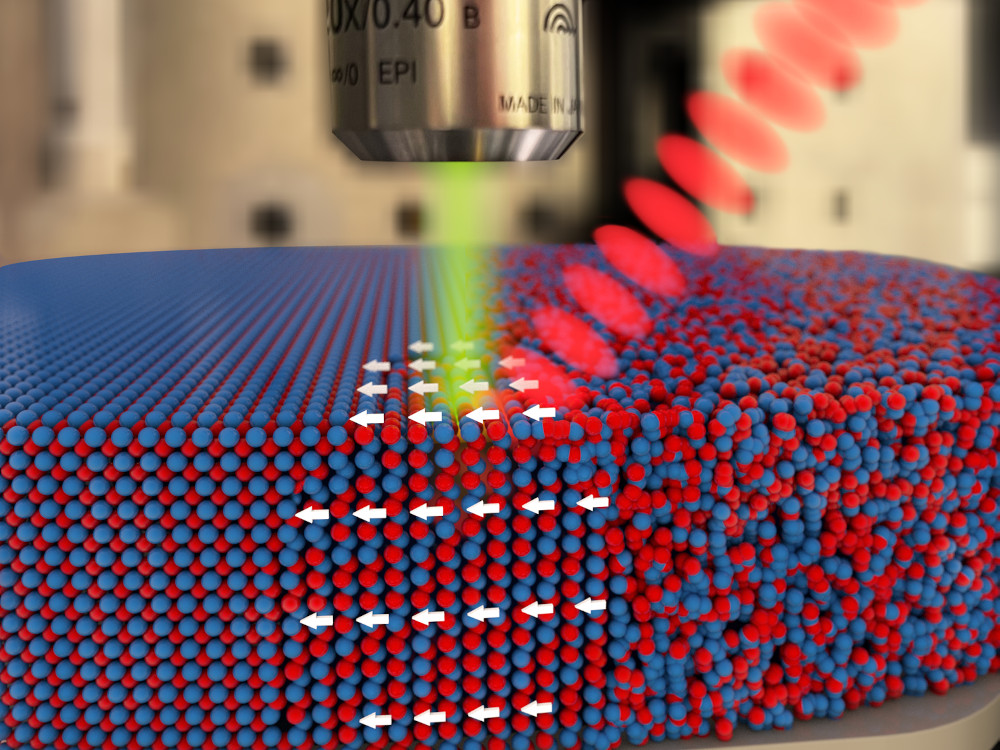
20 Dec Laser pulses create localized magnetic spots
When a team led by the Helmholtz-Zentrum Dresden-Rossendorf (HZDR) irradiated a thin layer of an iron-aluminum alloy with ultrashort laser pulses in 2018, the non-magnetic material suddenly became magnetic. The researchers’ explanation: The laser pulses rearrange the atoms in the crystal so that the iron atoms move closer together, forming a magnet. The layer could then be demagnetized again with a series of weaker laser pulses. The researchers had thus discovered a way of specifically creating and erasing a type of tiny magnetic spot on a surface.
However, the pilot experiment left questions unanswered. “It was unclear whether the effect only occurs with the iron-aluminium alloy or also with other materials,” explains Dr. Rantej Bali, physicist at the Institute of Ion Beam Physics and Materials Research at the HZDR. “We also wanted to try to track the process over time.” To clarify this, he teamed up with Dr. Theo Pflug from the Laser Institute at Mittweida University of Applied Sciences (LHM) and colleagues from the University of Zaragoza in Spain.
Works with various materials
The experts examined an alloy of iron and vanadium. Unlike the iron-aluminum alloy, the atoms are not layered to form a regular crystal lattice, but are arranged more chaotically. They form an amorphous, glass-like structure. In order to observe what happens after laser irradiation, the physicists used the pump-probe method. “First, we shine a strong laser pulse onto the alloy, which magnetizes the material,” explains Theo Pflug. “Then we send a weaker pulse after it, which is reflected by the material surface.”
The analysis of the laser reflections allows conclusions to be drawn about the physical properties of the material. The game is then repeated several times, whereby the time interval between the pump pulse and the subsequent sample pulse is continually increased. At the end, a time series of reflection data is obtained, from which it is possible to reconstruct which processes the stimulating laser pulse has set in motion.
Molten material magnetized
The result: although it has a different basic structure to the iron-aluminium compound, the iron-vanadium alloy can also be magnetized by laser. “In both cases, the material melts briefly at the irradiated point,” explains Bali. “This causes the laser to erase the previous structure, so that a small magnetic area can form in both alloys.” This showed that the phenomenon is not limited to a specific material structure, but occurs in various atomic arrangements.
The team is also on the trail of the temporal sequence of the process: “At least we now know in which time ranges something happens,” explains Pflug. “Within femtoseconds, the laser pulse excites the electrons in the material. Later, after several picoseconds, the excited electrons transfer their energy to the atomic nuclei.” This energy transfer then causes the rearrangement into a magnetic structure, which is fixed by the subsequent rapid cooling. How exactly the atoms rearrange themselves will be observed in follow-up experiments by illuminating the magnetization process with intense X-rays.
Applications: Sensors, data storage and transmission
Even this work at the basic stage provides initial ideas for possible applications: For example, it is conceivable to use lasers to place tiny magnets on a chip surface in a targeted manner. “This could be useful for the production of sensitive magnetic sensors, for example in vehicles,” speculates Bali. “It could also be used for magnetic data storage.” The phenomenon also seems interesting for a new type of electronics, spintronics. Here, magnetic signals are to be used for digital computing processes instead of electrons passing through transistors as usual – a possible approach for the computers of the future.
Original publication:
[T. Pflug, J. Pablo-Navarro, S. Anwar, M. Olbrich, C. Magén, M. R. Ibarra, K. Potzger, J. Faßbender, J. Lindner, A. Horn, R. Bali: Laser-Induced Positional and Chemical Lattice Reordering Generating Ferromagnetism, Advanced Functional Materials, 2023 (DOI: 10.1002/adfm.202311951)]
Image: Sander Münster / HZDR
Source: www.hzdr.de






